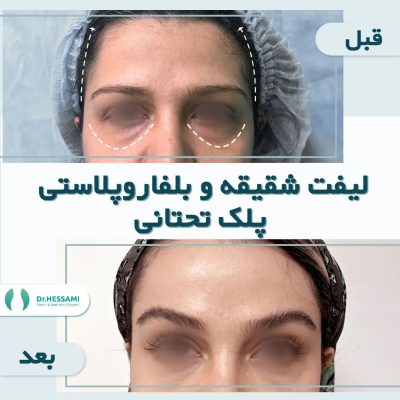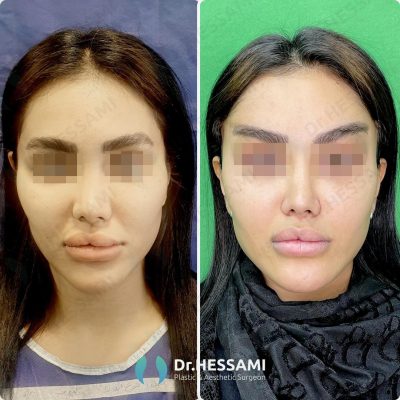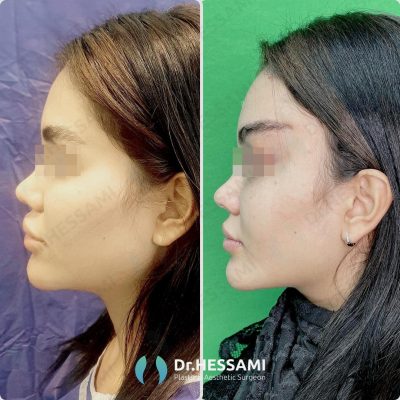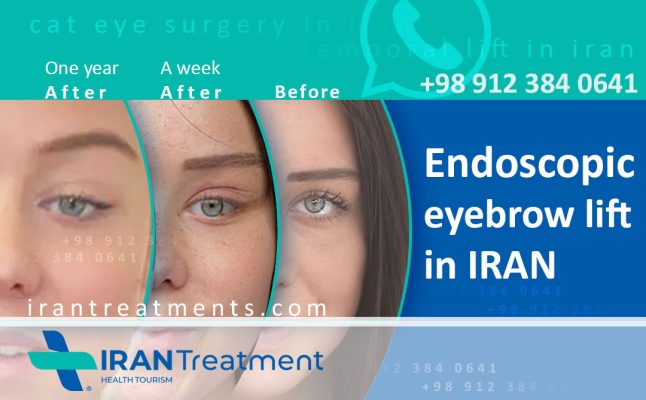Endoscopic temporal lift in Iran
An endoscopic temporal lift in Iran , also known as an endoscopic brow lift, is a minimally invasive procedure that aims to elevate the outer portion of the eyebrows and smoothen the skin around the temples and the corners of the eyes.
Endoscopic temporal lift in Iran is a less invasive procedure than a traditional brow lift. This technique uses an endoscope, a thin tube with a light and camera attached to it, to guide the surgery.
If you want to operate in Tehran, Dr Hessami, click the button below and follow the stepsStart your therapeutic journey
Here’s an overview of the procedure:
1. Anesthesia: The patient is usually given local anesthesia, sedation, or general anesthesia, depending on the surgeon’s and patient’s preference.
2. Incisions: The surgeon makes several small incisions behind the hairline. These are much smaller than those required for a traditional brow lift, which means less scarring.
3. Insertion of the endoscope: The surgeon then inserts the endoscope through one of the incisions. The camera on the endoscope allows the surgeon to see and work on the internal structures of the forehead and brow without having to make a large incision.
4. Adjustment of tissues: The surgeon uses small instruments inserted through the other incisions to lift the forehead tissues and anchor them in place. This raises the brows and smooths out wrinkles on the forehead and between the eyes.
5. Closing the incisions: The incisions are usually closed with sutures or staples, which are removed after a week or two.
The endoscopic technique has several advantages over a traditional brow lift:
– It’s less invasive, meaning less scarring and usually a quicker recovery time.
– There’s less risk of complications such as infection or bleeding.
– It can often be done on an outpatient basis, which means the patient can go home the same day.
That said, an endoscopic temporal lift in Iran may not be suitable for everyone. For people with significant sagging or excess skin, a traditional brow lift may be more effective.
As with any surgical procedure, there are risks involved, including the risk of infection, bleeding, scarring, and reactions to anesthesia. It’s important to discuss these risks with your surgeon before deciding whether this is the right procedure for you.
Temporal lift surgery
Temporal lift surgery, also known as a temporal brow lift, This is typically done to reduce signs of aging such as sagging or drooping eyebrows, crow’s feet, and wrinkles on the forehead.
Here’s a simplified description of the procedure:
1. Consultation: The first step is usually a consultation with a plastic surgeon to discuss the patient’s goals, health history, and other relevant factors. This is to ensure that the patient is a suitable candidate for the procedure and has realistic expectations.
2. Anesthesia: The procedure can be performed under local or general anesthesia, depending on the patient’s preference and the surgeon’s recommendation.
3. Incisions: The surgeon makes small incisions in the scalp, usually hidden within the hairline to minimize visible scarring.
4. Elevating the skin and muscles: Using special tools, the surgeon gently lifts the skin and underlying muscles in the temporal area. This smooths out wrinkles and lifts the outer part of the eyebrows.
5. Closing the incisions: The incisions are then closed with sutures or staples. These are usually removed after a week or two.
6. Recovery: Recovery time can vary, but most patients can return to normal activities within a week or two. Some swelling, bruising, and discomfort are normal and can be managed with medication.
Like all surgical procedures, a temporal lift carries certain risks, such as infection, bleeding, scarring, and adverse reactions to anesthesia. Therefore, it’s important to discuss these potential complications with the surgeon before deciding to proceed.
Keep in mind that while a temporal lift can help improve the appearance of aging, it cannot stop the aging process altogether. Therefore, the results, while long-lasting, are not permanent. Regular skin care and sun protection can help maintain the results for as long as possible.
Lastly, it’s vital to choose a board-certified plastic surgeon with specific experience in facial cosmetic surgery to ensure the best possible results and minimize risks.
Cost and price of endoscopic temporal lift in Iran
The cost of endoscopic temporal lift surgery in Tehran 2024
(Endoscopic eyebrow lift surgery, endoscopic temple lift is also similar to this surgery)
- The cost of endoscopic temporal lift surgery in Tehran is between 1500 to 2500 euros
- Usually one night stay in the hospital is considered
- If you are not a resident of Tehran, the duration of stay in Tehran is 6 days
The cost of endoscopic temporal lift surgery in Tehran |
1500 euros |
including surgeon + hospital fee | |
| Other costs related to endoscopic temporal lift surgery in Tehran | |||
| Cost of blood test | Between 10 and 15 euros | The difference depends on the type of blood test | |
| The cost of consultation with a cardiologist | Between 20 and 40 euros | For people over 40 or heart patients | |
| The cost of medicine and other health items | Between 10 and 20 euros | ||
| temporal lift plastic surgery cost – optional | |||
| Nurse fee (per night) | 30 euros | If you are traveling alone | |
| The cost of changing the dressing by the nurse | |||
Attention:
- If you have an underlying disease or medication, let us know
- If you have already operated on the forehead, the cost of the surgery will increase slightly
- Let us know if you have anemia or other blood disorders
What to expect from temporal lift
A temporal lift or temporal brow lift is a surgical procedure designed to address signs of aging in the upper face. This procedure can help raise the outer portion of the eyebrows, improve the appearance of crow’s feet, and smooth the skin around the temples. Here’s what you can generally expect before, during, and after the procedure:
Before the Procedure
During your initial consultation, your surgeon will discuss your aesthetic goals, review your medical history, and explain the procedure in detail.
You may be asked to:
– Stop smoking several weeks before surgery to promote better healing.
– Avoid taking aspirin, certain anti-inflammatory drugs, and some herbal supplements as they can increase bleeding.
– Hydrate frequently, both before and after the surgery.
During the Procedure
The procedure often takes 1-2 hours, depending on the complexity of your case. It’s typically performed under local or general anesthesia. The surgeon will make small incisions hidden within the hairline and use special tools to lift the skin and underlying muscles in the temporal area.
After the Procedure
Following the surgery, you can expect some swelling, bruising, and discomfort in the treated area. These symptoms are usually temporary and can be managed with prescribed medications.
Here’s what the recovery process might look like:
– Immediately After: You might have a bandage around your forehead to minimize swelling and bruising.
– First Few Days: You may experience some discomfort, swelling, and bruising, which typically peak within the first 48 hours and then start to subside.
– 1-2 Weeks: Most of the noticeable swelling and bruising should have faded. Any non-dissolvable sutures or staples used to close the incisions are usually removed around this time. Most patients feel comfortable returning to work and other normal activities within two weeks, although this varies between individuals.
– Several Weeks: Swelling should continue to decrease, and the final results of your temporal lift should start to become apparent. However, it can take several months for all swelling to resolve and for the full results of the surgery to be visible.
Results
A temporal brow lift can provide a rejuvenated and more youthful appearance to the upper face. While the results are not permanent (since the procedure does not stop the aging process), they are typically long-lasting. Regular skincare and sun protection can help maintain the results.
As with any surgical procedure, there are potential risks and complications, including infection, bleeding, scarring, and adverse reactions to anesthesia. Be sure to discuss these with your surgeon prior to the procedure.
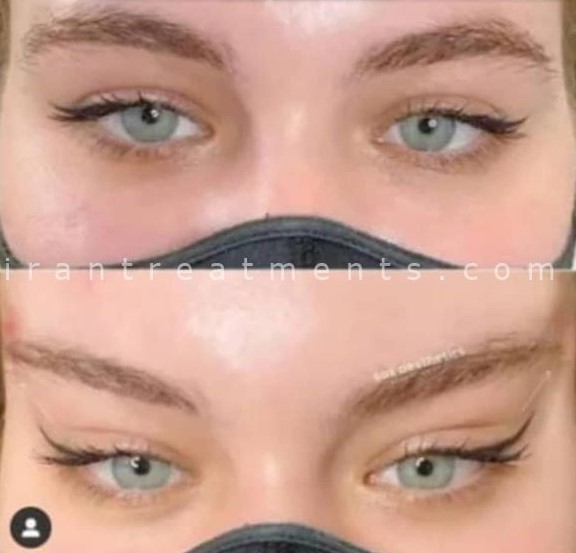
What happens during endoscopic temporal lift
An endoscopic temporal lift or endoscopic brow lift is a minimally invasive procedure designed to rejuvenate the area around the eyebrows and the upper face. This procedure can help lift the outer part of the eyebrows, reduce the appearance of crow’s feet, and smooth out wrinkles on the forehead.
Here’s a step-by-step description of what happens during the procedure:
1. Preparation: Before the procedure begins, the patient is prepared for surgery. This typically involves cleaning the surgical area and administering anesthesia. The type of anesthesia used can be local, sedation, or general, depending on the specific circumstances of the procedure and the preferences of the patient and surgeon.
2. Incisions: The surgeon makes several small incisions behind the hairline. The exact number and placement of the incisions can vary, but the goal is to keep them hidden within the hair to minimize visible scarring.
3. Insertion of the Endoscope: An endoscope, a thin tube with a light and camera attached, is inserted through one of the incisions. The camera allows the surgeon to visualize the structures beneath the skin without having to make a large incision.
4. Lifting the Tissues: Using small surgical instruments inserted through the other incisions, the surgeon lifts and repositions the skin and underlying tissues of the forehead. This helps to raise the outer part of the eyebrows and smooth out wrinkles.
5. Securing the Tissues: Once the tissues have been repositioned, they are often secured in their new position with small anchors. These anchors help maintain the lift and are usually absorbable, meaning they don’t need to be removed.
6. Closing the Incisions: The incisions are then closed with sutures or staples. These are typically removed after a week or two, although some sutures are absorbable and don’t require removal.
The procedure typically takes between 1 to 2 hours, depending on the complexity of the case.
After the surgery, patients can expect some swelling and bruising, which typically subsides over the course of several weeks. Most patients can return to normal activities within a week or two, although this can vary based on individual circumstances.
As with any surgical procedure, there are potential risks and complications, including infection, bleeding, scarring, and adverse reactions to anesthesia. Be sure to discuss these with your surgeon prior to the procedure.
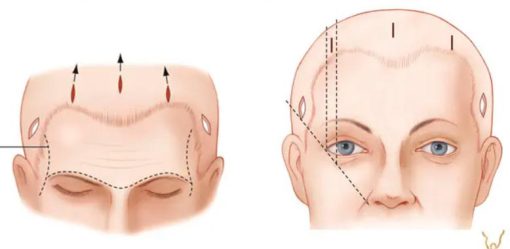
What is the recovery process after endoscopic temporal lift in Iran
After undergoing an endoscopic temporal lift in Iran , the recovery process generally involves some downtime, but it is typically shorter and less intensive than the recovery from more invasive procedures. Here’s what you can generally expect during the recovery process:
Immediately After Surgery:
You’ll be moved to a recovery area where medical staff will monitor you as the anesthesia wears off. Depending on the specifics of your procedure and your general health, you might be able to go home the same day.
First Few Days:
You can expect some swelling, bruising, and discomfort in the days following the surgery. Your doctor will likely prescribe medication to help manage the pain. Applying cold compresses can help reduce swelling.
First Week:
You should keep your head elevated as much as possible to help reduce swelling. Avoid strenuous activities, heavy lifting, and vigorous exercise. Many patients are able to return to work and other normal activities within a week, but this can vary between individuals.
After One to Two Weeks:
Any non-dissolvable sutures or staples will likely be removed around this time. Most of the noticeable swelling and bruising should have subsided, so the early results of your surgery will start to become visible.
Several Weeks to Months:
It may take several weeks to months for the swelling to fully subside and for the final results of the endoscopic temporal lift in Iran to be fully visible. As the healing process continues, the incision scars should fade and become less noticeable over time.
Throughout the recovery period, it’s crucial to follow all post-operative instructions provided by your surgeon. This can include wound care instructions, medication schedules, and guidelines on when you can return to certain activities.
Remember to schedule and attend all follow-up appointments so your surgeon can monitor your healing process. These appointments are also a good opportunity to discuss any concerns or questions you have about your recovery.
As with any surgical procedure, there are potential risks and complications, such as infection, bleeding, changes in sensation, and adverse reactions to anesthesia. If you notice any unusual symptoms or if your pain increases suddenly, contact your healthcare provider immediately.
Diet after endoscopic temporal lift
While there are no specific dietary restrictions after an endoscopic temporal lift in Iran , some general guidelines can help ensure a smooth recovery. Here are some suggestions:
Hydration: Hydrate well before and after the procedure. Water helps to flush out toxins and aids in healing.
Healthy Eating: A balanced diet rich in fruits, vegetables, lean proteins, and whole grains can provide the nutrients needed for healing.
Protein: Consuming sufficient protein is essential for wound healing. Include sources of lean protein like chicken, fish, eggs, and tofu in your diet.
Vitamin C: Vitamin C plays a key role in collagen synthesis, which is important for wound healing. Foods rich in Vitamin C include citrus fruits, strawberries, bell peppers, and broccoli.
Avoid Alcohol: Alcohol can interfere with your body’s healing process and can potentially interact with any prescribed medications. It’s best to avoid alcohol for at least a week before and after surgery, or as recommended by your surgeon.
Limit Sodium: High sodium intake can increase swelling, so it’s best to avoid foods high in salt.
Avoid Hard-to-Chew Foods: Immediately after the surgery, you may want to stick to soft, easy-to-chew foods to avoid straining your facial muscles.
No Smoking: Smoking can hinder the healing process by constricting blood vessels and reducing oxygen supply to tissues. It’s best to avoid smoking for several weeks before and after surgery.
Remember that these are general recommendations, and individual needs can vary. Always follow the specific post-operative care instructions given by your surgeon.
It’s also crucial to keep in mind that while a good diet can support healing, it cannot guarantee a problem-free recovery. Be sure to reach out to your healthcare provider if you have any concerns during your recovery period.
How to sleep after endoscopic temporal lift
After an endoscopic temporal lift in Iran , the way you sleep can impact your recovery process and the final result. Here are some tips on how to sleep after the procedure:
1. Elevate Your Head: Keeping your head elevated can help reduce swelling. You can use a few pillows to prop your head up, or consider using a recliner. Some people find it helpful to use a travel pillow to keep their head from moving side-to-side.
2. Sleep on Your Back: Try to sleep on your back rather than on your side or stomach. This helps avoid pressure on the surgical area and reduces the risk of disrupting the healing process.
3. Avoid Rolling Over: If you often roll over in your sleep, consider using additional pillows as barriers on either side.
4. Stay Comfortable: Make sure your sleeping area is comfortable and peaceful. This can help you get the rest you need for your body to heal.
5. Follow Surgeon’s Instructions: Always follow your surgeon’s specific post-operative instructions, which may include additional advice about sleeping positions.
It’s important to remember that everyone’s recovery process is unique, and it’s normal to have some discomfort while sleeping in the first few days after the surgery. However, if you experience severe pain, or if the discomfort does not improve over time, contact your healthcare provider.
The best age for endoscopic temporal lift
The best age for an endoscopic temporal lift in Iran can vary greatly from person to person, as it largely depends on individual signs of aging, skin condition, and personal aesthetic goals rather than a specific age. However, most people who seek this procedure are typically in their 40s to 60s, as this is when significant aging signs like sagging brows and wrinkles in the forehead area often become more noticeable.
Key factors to consider when determining the right time for an endoscopic temporal lift in Iran include:
Physical Signs: This procedure is typically performed to address sagging eyebrows, forehead wrinkles, and creases between the eyebrows. If these signs of aging are noticeable and bother you, it might be the right time to consider this procedure.
Health Status: Good candidates for an endoscopic temporal lift in Iran should be in good overall health, without any medical conditions that could hinder healing or increase surgery risks.
Lifestyle: Habits such as smoking can impact your ability to heal after surgery. It’s important to quit smoking several weeks before and after the procedure to ensure the best possible results.
Expectations: Having realistic expectations about what the procedure can and cannot achieve is essential. An endoscopic temporal lift in Iran can help you look more refreshed and youthful, but it won’t fundamentally change your appearance or make you look like someone else.
Remember that a personal consultation with a qualified plastic surgeon is the best way to determine whether you’re a good candidate for an endoscopic temporal lift in Iran and when the optimal time for the procedure might be for you.
How long after endoscopic temporal lift can you exercise
The timeline for returning to exercise after an endoscopic temporal lift in Iran can vary based on the specifics of the procedure and individual healing rates. However, as a general guideline, most surgeons recommend a gradual return to physical activity.
First Few Days: During the first few days after surgery, rest is crucial. You should avoid any strenuous activity and focus on recovery.
First Week: Light walking can typically be resumed within the first week to promote good blood circulation, as long as it does not cause discomfort or strain.
Two to Three Weeks: More strenuous activities, such as running or aerobics, can often be resumed after about two to three weeks, depending on how you’re healing.
Four to Six Weeks: Activities that involve heavy lifting or strain on the face, like weightlifting, may need to be avoided for four to six weeks or until your surgeon gives you the all-clear.
Remember, these timelines are just a guideline, and individual recovery times can vary. It’s crucial to listen to your body and not rush your return to physical activity. Pushing yourself too hard can increase your risk of complications and hinder the healing process.
Always follow your surgeon’s specific post-operative instructions, which may include more detailed guidance on when you can return to different types of physical activity.
Durability for endoscopic temporal lift
The results of an endoscopic temporal lift in Iran can be long-lasting, but they are not permanent because they can’t stop the natural aging process. The durability of the results depends on a number of factors, including the individual’s skin quality, lifestyle, and genetics.
Generally, the results of an endoscopic temporal lift can last anywhere from 5 to 10 years, or even longer for some patients. However, over time, the skin and soft tissues will continue to age, which can lead to the recurrence of sagging and wrinkles.
Factors that can affect the longevity of the results include:
1. Skin Elasticity: Individuals with good skin elasticity often see more durable results, as their skin is better able to maintain the lift.
2. Lifestyle: Habits such as smoking or prolonged sun exposure can accelerate skin aging and may shorten the lifespan of the results. A healthy lifestyle, including a balanced diet, regular exercise, and proper skin care, can help prolong the effects.
3. Genetics: Some people naturally age slower than others due to their genetic makeup.
4. Follow-up Care: Following your surgeon’s post-operative care instructions can also influence the durability of the results.
If you notice that the effects of your endoscopic temporal lift in Iran are diminishing over time, you can discuss options with your surgeon. Some people choose to have touch-up procedures or complementary treatments to maintain their desired look.


